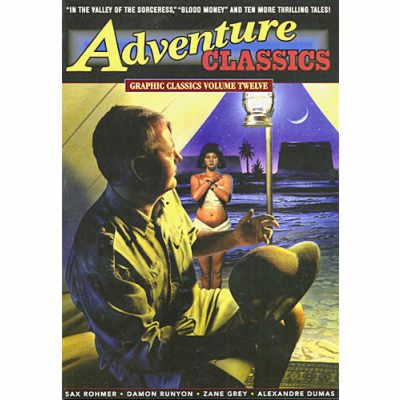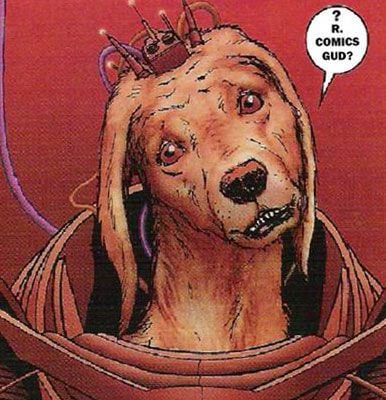This Comic Is Good - Adventure Classics
Tom Pomplun sent me a copy of the latest collection of Eureka Productions' Graphic Classics series (Volume Twelve, to be precise), Adventure Classics, and I am really glad that he did, because it is a wonderful collection.
Graphic Classics are essentially just like the classic "Classics Illustrated" of the past - comic book adaptations of stories by notable authors.
This collection features, well, adventure stories (I know, I know, that must come as quite a surprise), from the likes of Damon Runyon, Zane Grey and Alexandre Dumas.
On a critical level, it is not fair of me to judge the writing, as the writing is obviously good, as Pumplun's group obviously took great stories from famous writers, so the odds are quite high that the stories will be good.
No, to judge this book critically, it will have to rest on the adaptations of the stories and the artwork.
In both cases, the book passes with flying colors (although more so for the former).
The adaptations are sparkling, as you can barely tell in most of the instances that the books were not INTENDED to be read in comic book format.
As for the art, a wide variety of artists worked on the comic, so quality definitely varies, but for the most part, the artwork is quite impressive, which is especially nice to see as I was not familiar with most of the artists involved.
The cover of the collection is a striking, Ray Lago-esque painting by Chris Moore.

The first story, Sax Rohmer's chilling tale of mystery on an archaeological dig in Egypt, was probably my least favorite, art-wise. Rod Lott adapted the story well, storywise, but I do not know if J.B. Bonivert's style fully fit the story or, if the STYLE worked, then perhaps Bonivert just did not pull it off (and you can imagine what I was thinking the rest of the comic would look like, being disappointed in the art for the FIRST story).
However, Michael Manning came back with a strong art job on Alexandre Dumas' The Monster Ball.
Don Marquez followed with my second or third favorite art job, showing a major Frazetta influence (and, for the record, I just spent a good four to five minutes staring at the art, trying to figure out WHO his art reminded me of...hehe) on the Zane Grey tale, "Tigre," which is such an detailed tale, the comic book format really helps with the story.
My favorite art job is on the next story, a Damon Runyon adaptation by Noel Tuazon. This was also probably my favorite story in the whole book (O. Henry's entry is closest). Runyon sure knew how to write a popular story.
Kevin Atkinson gives a colorful (which is impressive, as the book is black and white) rendition of Rafael Sabatini's inimitable Captain Blood character. It was quite striking at how the style of art really painted a different picture. Atkinson's stlye gave the story a real bounding appeal...I think a darker artist would greatly affect the impact of the story.
Chris Pelletiere does a good job handling the noir feel of The Stolen Story, by Jonston McCulley, although I felt there were a few panels that seemed a bit unintentionally loose.
Pedro Lopez was right there with Don Marquez in his rendition of O. Henry's The Roads We Take, which is a really cool story (adapted quite well by Rod Lott), and shows why O. Henry was so darn popular (and why Eureka has devoted an entire collection to JUST O. Henry stories!).
The previous stories (other than the two adapted by Lott) were adapted by Pomplun, who does a strong job.
The only other non-Pomplun adapted stories are Milton Knight's suitably wacky adaptation (including the art as well) of Fitz-James O'Brien's The Man Without a Shadow and Antonella Caputo's strong adaptations of Edith Nesbit's The Mystery of the Semi-Detached (with solid art from Mark A. Nelson) and Arthur Conan Doyle's The Crime of the Brigadier (with art by Nick Miller that is quite reminscient of Sergio Aragones and Albert Uderzo).
There are also three illustrated poems, which range from simply drawings along with poems, such as Skot Olsen's drawing alongside Robert Louis Stevenson's poem The Wind Blew Shrill and Smart that opens the entire collection, and Mary Fleener's drawings for Rudyard Kipling's Gunga Din, to the Mad Magazine-esque rendition of The Shooting of Dan McGrew, written by Rober W. Service, and detailed by Hunt Emerson.
Add four pages of biographical information for each author and artist, and you have yourself here a very smart, attractive, package, delivered with distinct care.
Graphic Classics are essentially just like the classic "Classics Illustrated" of the past - comic book adaptations of stories by notable authors.
This collection features, well, adventure stories (I know, I know, that must come as quite a surprise), from the likes of Damon Runyon, Zane Grey and Alexandre Dumas.
On a critical level, it is not fair of me to judge the writing, as the writing is obviously good, as Pumplun's group obviously took great stories from famous writers, so the odds are quite high that the stories will be good.
No, to judge this book critically, it will have to rest on the adaptations of the stories and the artwork.
In both cases, the book passes with flying colors (although more so for the former).
The adaptations are sparkling, as you can barely tell in most of the instances that the books were not INTENDED to be read in comic book format.
As for the art, a wide variety of artists worked on the comic, so quality definitely varies, but for the most part, the artwork is quite impressive, which is especially nice to see as I was not familiar with most of the artists involved.
The cover of the collection is a striking, Ray Lago-esque painting by Chris Moore.

The first story, Sax Rohmer's chilling tale of mystery on an archaeological dig in Egypt, was probably my least favorite, art-wise. Rod Lott adapted the story well, storywise, but I do not know if J.B. Bonivert's style fully fit the story or, if the STYLE worked, then perhaps Bonivert just did not pull it off (and you can imagine what I was thinking the rest of the comic would look like, being disappointed in the art for the FIRST story).
However, Michael Manning came back with a strong art job on Alexandre Dumas' The Monster Ball.
Don Marquez followed with my second or third favorite art job, showing a major Frazetta influence (and, for the record, I just spent a good four to five minutes staring at the art, trying to figure out WHO his art reminded me of...hehe) on the Zane Grey tale, "Tigre," which is such an detailed tale, the comic book format really helps with the story.
My favorite art job is on the next story, a Damon Runyon adaptation by Noel Tuazon. This was also probably my favorite story in the whole book (O. Henry's entry is closest). Runyon sure knew how to write a popular story.
Kevin Atkinson gives a colorful (which is impressive, as the book is black and white) rendition of Rafael Sabatini's inimitable Captain Blood character. It was quite striking at how the style of art really painted a different picture. Atkinson's stlye gave the story a real bounding appeal...I think a darker artist would greatly affect the impact of the story.
Chris Pelletiere does a good job handling the noir feel of The Stolen Story, by Jonston McCulley, although I felt there were a few panels that seemed a bit unintentionally loose.
Pedro Lopez was right there with Don Marquez in his rendition of O. Henry's The Roads We Take, which is a really cool story (adapted quite well by Rod Lott), and shows why O. Henry was so darn popular (and why Eureka has devoted an entire collection to JUST O. Henry stories!).
The previous stories (other than the two adapted by Lott) were adapted by Pomplun, who does a strong job.
The only other non-Pomplun adapted stories are Milton Knight's suitably wacky adaptation (including the art as well) of Fitz-James O'Brien's The Man Without a Shadow and Antonella Caputo's strong adaptations of Edith Nesbit's The Mystery of the Semi-Detached (with solid art from Mark A. Nelson) and Arthur Conan Doyle's The Crime of the Brigadier (with art by Nick Miller that is quite reminscient of Sergio Aragones and Albert Uderzo).
There are also three illustrated poems, which range from simply drawings along with poems, such as Skot Olsen's drawing alongside Robert Louis Stevenson's poem The Wind Blew Shrill and Smart that opens the entire collection, and Mary Fleener's drawings for Rudyard Kipling's Gunga Din, to the Mad Magazine-esque rendition of The Shooting of Dan McGrew, written by Rober W. Service, and detailed by Hunt Emerson.
Add four pages of biographical information for each author and artist, and you have yourself here a very smart, attractive, package, delivered with distinct care.



0 Comments:
Post a Comment
<< Home